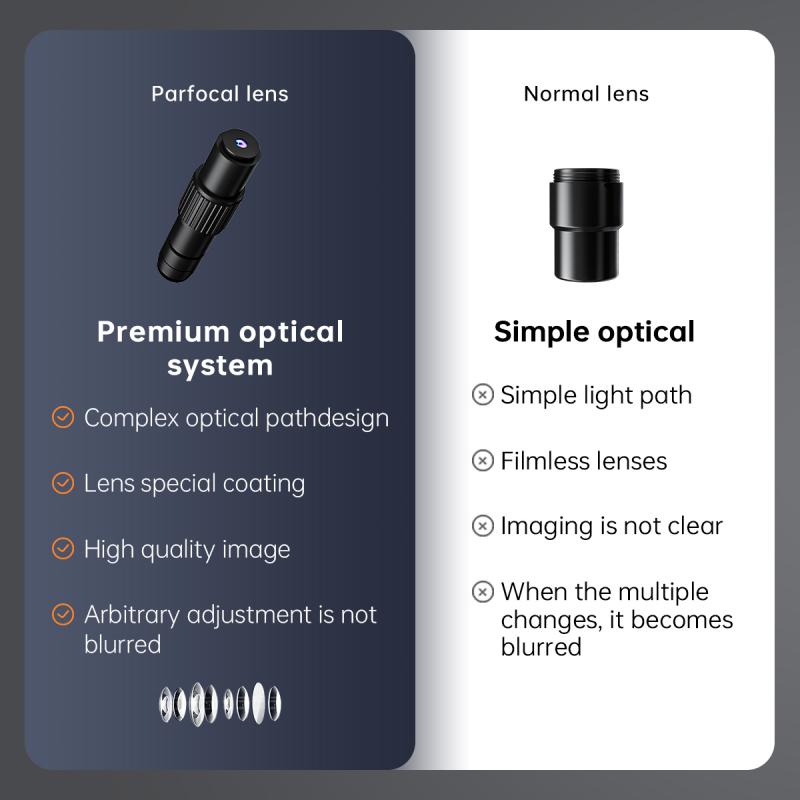How To Describe Cells Under A Microscope ?
When describing cells under a microscope, one would typically observe and note their size, shape, and overall appearance. This may include details about the cell's organelles, such as the nucleus, cytoplasm, and cell membrane. Additionally, one might describe any observable structures within the cell, such as mitochondria, endoplasmic reticulum, or vacuoles. It is also important to mention any specific characteristics or features that are unique to the type of cell being observed, such as cilia or flagella in certain types of cells. Overall, the description should provide a clear and concise account of the cellular structures and features visible under the microscope.
1、 Cell Structure and Organelles
When describing cells under a microscope, it is important to focus on their structure and organelles. Cells are the basic building blocks of all living organisms and can be classified into two main types: prokaryotic and eukaryotic.
Prokaryotic cells, such as bacteria, are simple in structure and lack a nucleus. They have a cell membrane, cytoplasm, and a single circular DNA molecule. Under a microscope, prokaryotic cells appear as small, round or rod-shaped structures.
Eukaryotic cells, found in plants, animals, fungi, and protists, are more complex. They have a distinct nucleus that houses the genetic material, surrounded by a nuclear membrane. Eukaryotic cells also contain various organelles, each with specific functions. These organelles include the mitochondria, responsible for energy production; the endoplasmic reticulum, involved in protein synthesis; the Golgi apparatus, responsible for packaging and transporting molecules; and the lysosomes, involved in cellular waste disposal.
Under a microscope, eukaryotic cells appear larger and more structured than prokaryotic cells. The nucleus is often visible as a dark, round structure, while other organelles may appear as smaller, distinct compartments within the cell.
It is worth mentioning that recent advancements in microscopy techniques, such as confocal microscopy and super-resolution microscopy, have allowed scientists to observe cells with greater detail and precision. These techniques have revealed new insights into cell structure and organelle dynamics, providing a deeper understanding of cellular processes.
In conclusion, describing cells under a microscope involves focusing on their structure and organelles. Prokaryotic cells are simple and lack a nucleus, while eukaryotic cells are more complex and contain various organelles. Recent advancements in microscopy techniques have enhanced our understanding of cell biology and provided new insights into cellular structures and functions.

2、 Cell Types and Classification
When describing cells under a microscope, it is important to consider their structure, function, and classification. Cells are the basic building blocks of all living organisms and can be classified into two main types: prokaryotic and eukaryotic cells.
Prokaryotic cells, such as bacteria, are simple in structure and lack a nucleus. They have a cell membrane, cytoplasm, and genetic material in the form of a single circular DNA molecule. Prokaryotic cells are typically smaller in size and have a simpler internal organization compared to eukaryotic cells.
Eukaryotic cells, found in plants, animals, fungi, and protists, are more complex. They have a distinct nucleus that houses the genetic material, surrounded by a nuclear membrane. Eukaryotic cells also contain various organelles, such as mitochondria, endoplasmic reticulum, Golgi apparatus, and lysosomes, which perform specific functions within the cell. These organelles are enclosed by membranes and contribute to the overall structure and function of the cell.
Furthermore, eukaryotic cells can be further classified into different types based on their specialized functions. For example, nerve cells (neurons) transmit electrical signals, muscle cells contract to produce movement, and epithelial cells line the surfaces of organs and tissues. Each cell type has unique characteristics and structures that enable them to carry out their specific functions.
It is worth mentioning that the latest point of view in cell classification includes the recognition of stem cells, which have the ability to differentiate into various cell types. Stem cells hold great potential in regenerative medicine and have opened up new avenues for research and treatment of various diseases.
In conclusion, describing cells under a microscope involves understanding their structure, function, and classification. Prokaryotic and eukaryotic cells differ in complexity, with eukaryotic cells having a nucleus and various organelles. Eukaryotic cells can be further classified into different types based on their specialized functions. The latest point of view in cell classification includes the recognition of stem cells, which have the ability to differentiate into various cell types.

3、 Cell Division and Reproduction
When describing cells under a microscope, it is important to consider their structure, function, and any observable changes during cell division and reproduction.
Under a microscope, cells can be observed in various stages of the cell cycle, including interphase, mitosis, and cytokinesis. During interphase, cells appear as distinct structures with a nucleus, cytoplasm, and organelles. The nucleus contains genetic material in the form of chromosomes, which are visible as condensed structures. The cytoplasm contains various organelles, such as mitochondria, endoplasmic reticulum, and Golgi apparatus, which are involved in cellular processes.
During cell division, the process of mitosis can be observed. Mitosis consists of several distinct stages, including prophase, metaphase, anaphase, and telophase. In prophase, chromosomes condense and become visible as distinct structures. In metaphase, chromosomes align along the equator of the cell. In anaphase, sister chromatids separate and move towards opposite poles of the cell. In telophase, two new nuclei form, and the cell begins to divide.
Cytokinesis, the final stage of cell division, involves the physical separation of the cytoplasm and organelles into two daughter cells. This process can be observed as the cell membrane pinches inward, eventually leading to the formation of two separate cells.
From a more recent perspective, advancements in microscopy techniques, such as confocal microscopy and super-resolution microscopy, have allowed for more detailed observations of cells. These techniques provide higher resolution and three-dimensional imaging, enabling researchers to study cellular structures and processes with greater precision.
In conclusion, describing cells under a microscope involves observing their structure, function, and changes during cell division and reproduction. Advancements in microscopy techniques have further enhanced our understanding of cellular processes and provided new insights into the intricate world of cells.

4、 Cell Movement and Migration
When describing cells under a microscope, it is important to consider their structure, function, and behavior. Cell movement and migration are crucial processes that play a significant role in various biological phenomena, such as embryonic development, wound healing, and immune response. Observing and understanding these processes can provide valuable insights into cellular behavior and contribute to advancements in fields like regenerative medicine and cancer research.
To describe cell movement and migration under a microscope, several key aspects should be considered. Firstly, the morphology of the cells should be examined. This involves observing the shape, size, and structure of the cells, as well as any specialized features such as lamellipodia or filopodia. Additionally, the arrangement and organization of cells within a tissue or culture can provide important information about their migratory behavior.
Furthermore, the mode of cell movement should be characterized. Cells can exhibit various modes of migration, including amoeboid, mesenchymal, or collective migration. Amoeboid movement involves the extension of pseudopodia and is typically observed in immune cells. Mesenchymal migration, on the other hand, involves the coordinated movement of cells through the degradation of extracellular matrix components. Collective migration occurs when groups of cells move together, often in a coordinated manner.
Recent advancements in microscopy techniques have allowed for more detailed and dynamic observations of cell movement and migration. Live-cell imaging, for example, enables the visualization of cells in real-time, providing insights into the mechanisms and dynamics of migration. Advanced imaging modalities, such as confocal microscopy and two-photon microscopy, offer high-resolution imaging and the ability to track individual cells over extended periods.
In conclusion, describing cells under a microscope requires careful examination of their morphology, mode of movement, and organization within a tissue or culture. The latest advancements in microscopy techniques have provided researchers with powerful tools to study cell movement and migration in unprecedented detail. By understanding these processes, we can gain a deeper understanding of cellular behavior and potentially develop new strategies for therapeutic interventions.






































